How much sodium are you consuming every day?
Believe it or not, the average American consumes over 3,500 mg of sodium daily! The CDC also reports that about 90% of Americans 2 years old and older consume too much sodium.
Current recommendations are for less than 2,300 mg of sodium per day (ideally less than 1,500 mg per day). So, the average American is consuming more than twice the ideal amount of sodium. And, this is a big deal because too much sodium leads to high blood pressure, heart disease and stroke. We have heard it for years…”we need to reduce our sodium intake”…so, why do we have such a hard time doing so?
As we approach the end of National Heart Health Month, we want to shine more light on this topic.
Where is the sodium coming from?
According to the CDC, over 70% of the sodium consumed is from processed and restaurant foods. And, more than 40% of the sodium consumed by Americans each day comes from these top 10 food categories:
- Breads and rolls
- Pizza
- Sandwiches (a simple turkey sandwich can have over 1,500 mg of sodium)
- Cold cuts and cured meats
- Soups
- Burritos and tacos
- Snacks like chips, pretzels, snack mixes and crackers
- Chicken dishes
- Cheese
- Eggs and omelets (it’s not the eggs, but everything added to them)
It’s important to realize there is a lot of sodium lurking in other grocery store foods as well…things like salad dressings, sauces, and cereal. And it can even show up in places you wouldn’t expect…such as in a simple can of diced tomatoes or in a can of black beans!
You may be thinking…why is there salt in a can of diced tomatoes? It should be just tomatoes, right? With some canned vegetables and beans, there is more than just the vegetable in there — they also have added salt! Why? Manufacturers often add salt to preserve flavor and prevent spoilage so they can last for years (yes, years) on the shelves or in our pantries.
What is the problem with sodium?
Getting too much sodium can lead to high blood pressure and increases the risk of heart disease and stroke.
Current recommendations are for less than 2,300 mg of sodium per day, with encouragement to limit intake to 1,500 mg per day (especially for those with high blood pressure, diabetes or kidney disease). If your sodium intake is too high, your kidneys have trouble keeping up. Your body will then hold onto water to dilute the sodium (which is why you might feel bloated and swollen after eating a couple slices of pizza). This increased fluid means your heart has to work harder and it puts increased pressure on your blood vessels.
Our bodies actually work best with more potassium than sodium. The potassium helps to relax blood vessels, get rid of sodium and reduce blood pressure….which is why we benefit from eating beans, avocados, dark leafy greens, and fish, to name a few. Unfortunately, for many Americans, their diets are just the opposite…more sodium than potassium.
So, what can you do?
Veggie-loaded meals:
Meals where plants (veggies, fruits, beans, whole grains, nuts and seeds) are the stars of the show will almost always help you achieve optimal sodium intake. A few tips include:
- Eat fresh and in-season whenever possible! These REAL foods are naturally low in sodium and many are high in potassium. Some high potassium foods include dark leafy greens (like spinach, kale and swiss chard), winter squash, potatoes and beans.
- Frozen vegetables are a great option! These can provide a huge convenience and time savings and typically don’t have added salt. Check the ingredients just to make sure there is nothing surprising lurking in the package.
- Rinse and drain! You can remove up to 40% of the sodium by rinsing and draining canned vegetables!
- Choose low-sodium or no-salt added canned vegetables! You can then add the salt yourself and adjust to your taste.
Compare the sodium and calories:
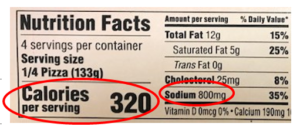 A useful rule of thumb is to look for foods where the sodium content is comparable to (or less than) the number of calories. If the sodium content is significantly higher than the calories, this is a red flag! For example, a Pizza Hut pepperoni personal pan pizza has 1,260 mg of sodium (you read right, almost 100% of the ideal daily amount). It has 610 calories, so the sodium content is more than 2x the calories – this should sound warning signals.
A useful rule of thumb is to look for foods where the sodium content is comparable to (or less than) the number of calories. If the sodium content is significantly higher than the calories, this is a red flag! For example, a Pizza Hut pepperoni personal pan pizza has 1,260 mg of sodium (you read right, almost 100% of the ideal daily amount). It has 610 calories, so the sodium content is more than 2x the calories – this should sound warning signals.
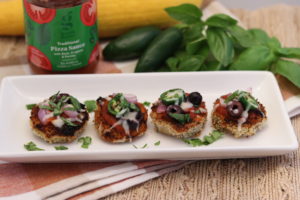 If you are thinking, “what a relief, I only eat healthier pizzas from the store,” beware, there can still be a lot of sodium lurking in the freezer section. For example, the DiGiorno pepperoni pizza has 800 mg of sodium (and 320 calories) per serving – again, this isn’t ideal. A better option would be to enjoy the Mini Eggplant Pizzas (190 mg sodium and 130 calories per serving).
If you are thinking, “what a relief, I only eat healthier pizzas from the store,” beware, there can still be a lot of sodium lurking in the freezer section. For example, the DiGiorno pepperoni pizza has 800 mg of sodium (and 320 calories) per serving – again, this isn’t ideal. A better option would be to enjoy the Mini Eggplant Pizzas (190 mg sodium and 130 calories per serving).
You don’t have to make this a hard and fast rule (after all, a little sauerkraut occasionally can be beneficial), but it can provide a useful way to help keep your overall sodium intake at healthy levels.
Other tips to reduce sodium:
 Read the ingredients! The good news is that many companies are trying to reduce sodium in their foods. However, you might be surprised how common added sodium is in many foods you probably already buy.
Read the ingredients! The good news is that many companies are trying to reduce sodium in their foods. However, you might be surprised how common added sodium is in many foods you probably already buy.- Use other herbs and seasonings! Use fresh or dried herbs to flavor your foods instead of salt. Lemon juice and different varieties of vinegar (including balsamic vinegar) are also great ways to add flavor! And, it is super-easy to make your own seasoning combinations.
- DIY salad dressing! In two minutes, you can whip up a flavorful, sodium-free salad dressing! Never buy bottled salad dressing again!
- Beware of the broth! Canned and pre-packaged chicken and vegetable broth can be very high in sodium. Try choosing low sodium options or, better yet, make your own and freeze it for multiple uses. You won’t believe how easy it is – the slow cooker can do the work for you!
- “No soup for you!” Canned and pre-packaged soups are a sodium paradise. Check out our coaching tip and make homemade soups whenever possible…it can be so easy and the taste is WAY better than the canned varieties.
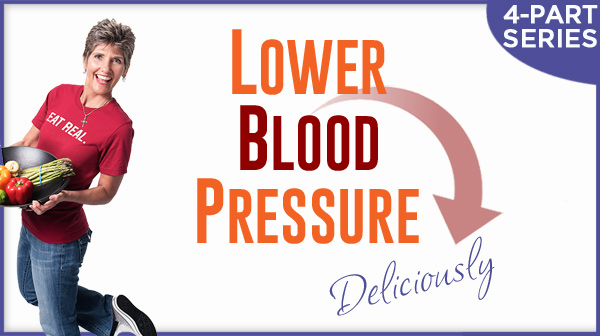 When you reduce the amount of sodium in your foods, you will be surprised how your cravings change!
When you reduce the amount of sodium in your foods, you will be surprised how your cravings change!
It may shock you when foods that tasted “perfectly fine” before suddenly start tasting way too salty! Yes, reprogramming your taste buds really does work!
If you are interested in seriously mastering a low sodium diet, getting your potassium where it needs to be, and surprising your doctor with the results, we encourage you to check out our 4-part online course called “Lower Blood Pressure Deliciously“. With four, go-at-your-own pace, recorded in-depth sessions, you will step your way through how to achieve success while your family raves about the recipes and meals — restaurant tips are covered too!
Remember, keep it simple and EAT REAL!
Image on sources of sodium developed by CDC and is available on the agency website for no charge. Reference to specific commercial products, manufacturers, companies, or trademarks does not constitute its endorsement or recommendation by the U.S. Government, Department of Health and Human Services, or Centers for Disease Control and Prevention.
 LEARN MORE ABOUT THE NAPKIN!
LEARN MORE ABOUT THE NAPKIN!
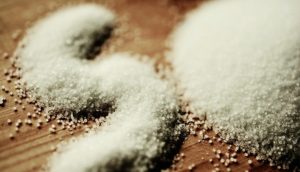
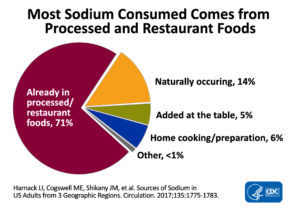
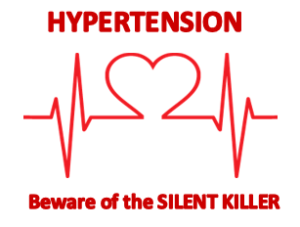

What a great article! Thank you. I think Zonya recommended 1500mg of sodium if you have high blood pressure OR are taking blood pressure medication(s). I’ve been tracking sodium in everything I eat to facilitate bringing down my blood pressure and I would add two things about significant amounts of sodium to the above. (1) When it comes to anything with made canned tomatoes or it’s juice, it’s a really good idea to compare sodium in different brands and cans – there can be HUGE differences. (2) Canned beans also often have large amounts of sodium (relative to a recommended daily maximum of 1500-2000mg limit), and some are even labeled low sodium, ESPECIALLY when compared to beans you cook at home from dry beans. If you have time or can plan ahead, these are also cheaper. We save time by cooking a large batch at a time, then divide the beans into 1-1/2 to 1-3/4 cup portions in zip lock bags (equivalent to a can of beans) then put them in labeled zip lock bags in the freezer. Then they’re ready when we need them in almost no time at all. Example of sodium comparison: (a) 1-3/4cup (equiv to a can) of red kidney beans cooked from dry w/o salt at home have aprox 4 mg of sodium. (b) A comparable quantity in a can of Great Value red kidney beans has per the can 910mg of sodium (you have to do the math to see how much is in a can) (c) A comparable quantity in a can of Organics brand organic red kidney beans has per the can 298mg of sodium (you have to do the math to see how much is in a can). If you eat as many beans as we do these days, that difference can really add up over the course of a week. AND it has proven to be a HUGE help in bringing down my blood pressure and helping me get off some blood pressure meds…a win-win in my book!!
Great pointers Sappho, thank you for sharing. And glad you pointed out, that 1,500 mg of sodium is recommended for people with high blood pressure, especially if they are taking blood pressure medication. (Just cause your medication is working to keep your pressure low, doesn’t mean you get to skate with more sodium) 😉